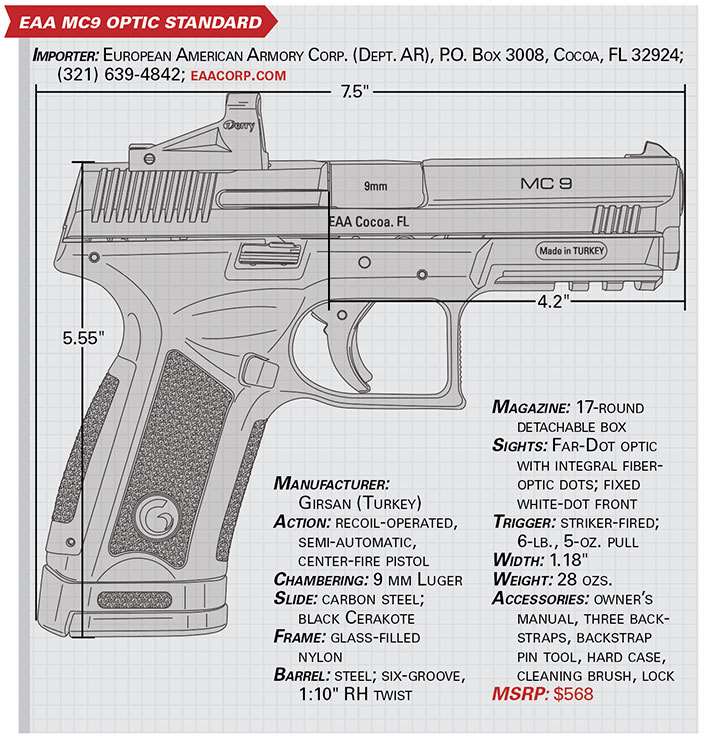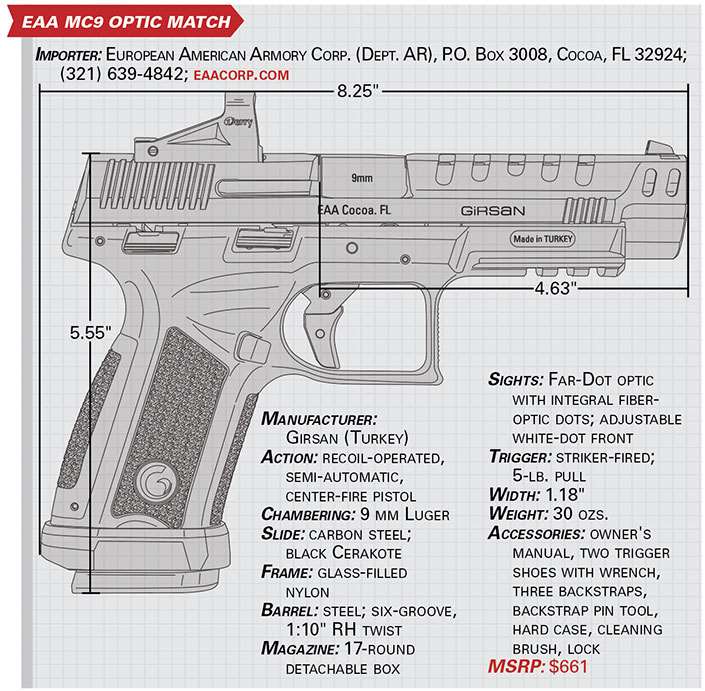
For several years now, European American Armory Corp. (EAA) has worked with Girsan of Turkey to import well-made pistols at affordable prices. Many of the models Girsan offers are based on popular semi-automatics, including the 1911A1 and Beretta 92 platforms, but one series that breaks away from the clone mold is the company’s MC28, which is a polymer-frame, striker-fired model in 9 mm Luger. Originally released in 2014, this pistol draws from a variety of modern defensive pistol influences. I got to work with the optics-ready MC28 last year, and found it to be a reliable, feature-rich pistol and red-dot package that was enjoyable to shoot, even though its cosmetics didn’t gladden my eye as much as some models do.
This year, Girsan and EAA have teamed up to launch an updated version of the MC polymer pistol series called the MC9, which is available in two optics-ready configurations. These models incorporate the new product launch of EAA’s in-house Far-Dot micro red-dot optic that includes a built-in rear sight system. Here is a closer look at the MC9 Optic Standard duty pistol and the factory-custom MC9 Optic Match race gun.
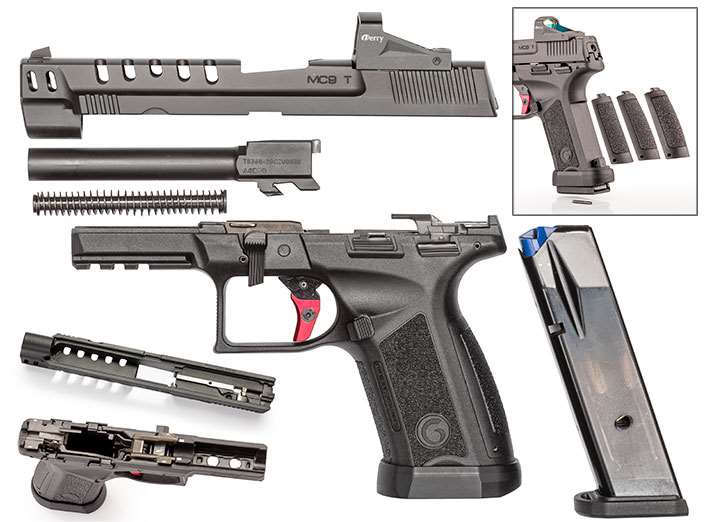
Like its predecessor, the MC9 Standard model is a recoil-operated, striker-fired, semi-automatic pistol with an internal configuration inspired by the Glock. Cosmetically, the pistol has been updated with a form and features more in line with the tactical pistols many American enthusiasts prefer. While the MC28 slide seems to be based on the Smith & Wesson M&P, the slides of the MC9 series bear more than a passing resemblance to classic SIG Sauer pistols such as the P226.
The carbon steel slide is treated with a matte-black Cerakote finish that matches the polymer frame. A fullsize set of slightly canted cocking serrations are located under the rear sight, and a shorter set of serrations is near the muzzle. A witness hole on top of the slide, at the rear of the barrel’s chamber, acts as a loaded-chamber indicator. The extractor’s claw is oversized for added purchase. The pistol has a striker block safety and a red indicator that peeks out through a port in the metal rear slideplate when the striker is cocked and retracts into the slide when it is uncocked.
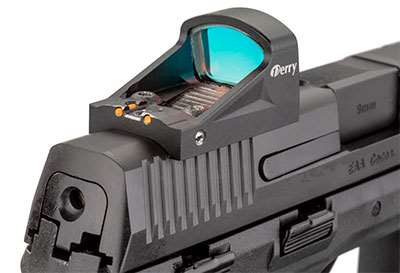
The metal white-dot front sight is secured to the slide by way of a small screw. This allows the sight to be traded out for a night-sight option, which will be available in the future. The optics-ready version of the MC28 shipped with a red-dot optic that used a mounting plate that wholly replaced the rear sight. The MC9’s new Far-Dot optic incorporates a square-notch, red fiber-optic rear sight into the back of the housing. The front and rear sight can be co-witnessed with the red-dot’s reticle, allowing for an easy transition to the iron sights should the optic lose power at a critical moment.
EAA’s Far-Dot optic is a micro reflex sight styled after the popular Shield RMS. Manufactured by Perry for EAA, the Far-Dot is configured to fit slides milled and tapped for the RMS, and does so without a mounting plate. The housing is made from durable, hard-coat-anodized aluminum. The multi-coated glass lens is illuminated by a red LED that projects a four minute-of-angle aiming point.
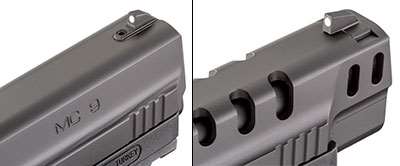
The aiming dot is always on and ready to use. There is no external power or brightness-control button. Instead, an internal sensor adjusts the dot’s brightness according to ambient lighting conditions. Storing the pistol with the Far-Dot’s protective rubber cover in place helps to extend the battery’s working life. Power is supplied for up to one year by a single CR 2032 three-volt button cell, which is protected from dust and moisture by a rubber seal. There is no battery access door, which means the sight will need to be removed from the slide for battery replacement.
The Far-Dot provides a clear, clean, easy-to-use sight picture for both the illuminated aiming point and the iron sights. It’s a useful sight configuration that can comfortably transition between the shooting range, competition and self-defense applications. The optic ships with a one-year warranty and will be available for sale as a stand-alone pistol accessory.
Getting back to the MC9 Standard pistol, the unthreaded 4.2" tilting barrel fits flush to the nose of the slide. It has a matte-black finish and traditional land-and-groove rifling with a 1:10" right-hand twist. Removing the slide from the frame reveals an internal configuration that mirrors that of the MC28, including a one-piece steel guide rod with a captured, flat-wire recoil spring.
The black polymer frame is constructed from sturdy, glass-filled nylon. The dustcover features a molded-in 1.90" three-slot Picatinny accessory rail to support light and laser modules. The trigger guard is generously sized with room for a gloved trigger finger, and includes a rounded undercut where it meets the grip. The front-facing edge of the trigger guard is flattened and textured to act as a finger rest.
The Standard version of the MC9 has a curved polymer trigger with a grooved face and integral blade safety lever. Listed as a single-action, the trigger exhibited the somewhat mushy take-up common to striker-fired pistols of this type. The trigger pull was a slightly heavy 6 lbs., 5 ozs., according to a Lyman digital trigger gauge, with a reasonably short trigger reset.
The external controls include a left-side takedown lever, bilateral slide stops and a reversible square-button magazine release. A raised lip in the frame around the slide stop prevents it from snagging on clothing or holsters.
The grip frame is shaped to be comfortable for a wide range of hand shapes and sizes. All four sides of the grip are treated to a moderately coarse molded-in stippled texturing that provides solid purchase without being abrasive to an ungloved hand. The pistol arrives with three interchangeable backstraps and a pin-removal tool. Although I have somewhat smaller hands, I found both MC9s to be comfortable to work with using the mid-size backstrap that is installed at the factory.
The base of the grip has right- and left-side indentations that aid in getting a good firm grip on the magazine baseplate in case the magazine needs to be pulled out of the grip. The MC9 employs a blued-steel, double-stack magazine with a polymer baseplate and blue polymer follower. This particular model will accept a 15-round magazine that fits flush with the base of the grip; however, it ships with a 17-round magazine that has a slip-on polymer grip extension that neatly fills the 0.25" gap between the grip and magazine baseplate.
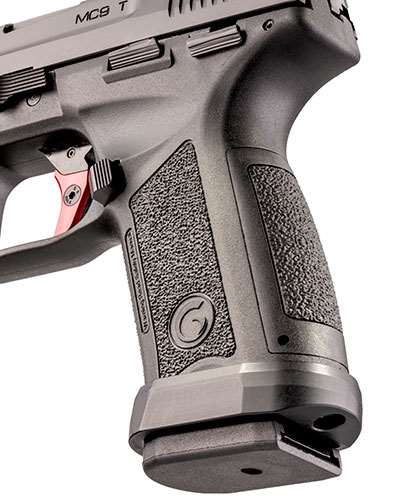
The Match version of the MC9 has a few key upgrades intended to entice the race-gun crowd. The unthreaded barrel is extended to 4.63" with a recessed competition crown. The slide is also longer, with a flush fit to the business end of the barrel. The slide features a series of seven weight-reduction vents along both sides. The white-dot front sight is dovetailed into the slide instead of being secured by a screw. The Far-Dot optic and rear sight configuration are the same as on the Standard model.
The low-profile takedown lever has been traded out for an extended and grooved version that serves as a thumb rest for the support hand. The magazine release is the same shape but 0.25" taller for easier access. The slide stops are the same, but behind them are unobtrusive, bilateral thumb safeties that take the place of the trigger safety.
The curved polymer trigger has been replaced with a milled aluminum competition trigger. The red-anodized trigger shoes are removable, and two shoes, along with a hex wrench, are provided with the pistol. One shoe has a gently curved profile while the other has a flat face. The trigger pull is noticeably cleaner than the Standard model with a shorter arc of travel. The trigger breaks cleanly with 5 lbs. of pressure, making it more than a pound lighter than the polymer Standard version.
The base of the grip frame is fitted with a removable aluminum magazine well extension. The interior edge of the magazine well is beveled to aid in quick reloads. The provided 17-round magazine fits flush to the magazine well, so no polymer extension is required.
I carefully examined the two Girsan MC9 pistols sent for this review, and found that, overall, the fit and finish demonstrated quality workmanship throughout both of them. The Cerakote finish on the slides was properly applied, the frames are neatly molded, and the exteriors were free of the dings and nicks that are sometimes imported along with other budget-priced pistols.
Each pistol ships with a hard case and a handful of accessories. In fact, the only fault I found with the kits is related to the proprietary magazines, namely, that the guns ship with only one when other companies are providing two or even three. I admit that single-magazine pistol packages are a pet peeve of mine, and I’m not going to give it up any time soon.
I enjoyed my time at the shooting range with the MC9 Optic models and found both trigger configurations to be comfortable to work with. The pistols balance nicely, and felt recoil is perfectly manageable with a variety of loads. The external controls all operated smoothly and properly, and the steel magazines are well-made. During range testing, the pistols were fired with a total of five factory magazines, all of which functioned flawlessly.
For those who have yet to spend much time shooting with a good micro red-dot optic affixed to a defensive pistol, their recent rise to prominence with several handgun manufacturers may seem to be a bit of a mystery. Simply stated, they are more intuitive to use than iron sights and make accurate shot placement easier at longer distances. This is especially true for those who use corrective lenses. The illuminated aiming point is visible in most lighting conditions but is particularly clear in the low-light conditions common to defensive situations. They lend themselves nicely to shooting with both eyes open, which is another noteworthy tactical advantage.
The MC9 pistol and Far-Dot optic proved to be a satisfyingly accurate combination. I tend to produce 3" to 3.5" groups at 25 yds. with good polymer-frame pistols when the gun, the ammunition and I are all doing our jobs. Using a red-dot optic helps to shrink my group sizes by as much as half an inch.
Along with the typical accuracy and velocity testing, I was looking for potential performance gaps that sometimes occur in 9 mm pistols, including the fact that, for some, changes in bullet weight or velocity can have a marked effect on downrange accuracy.
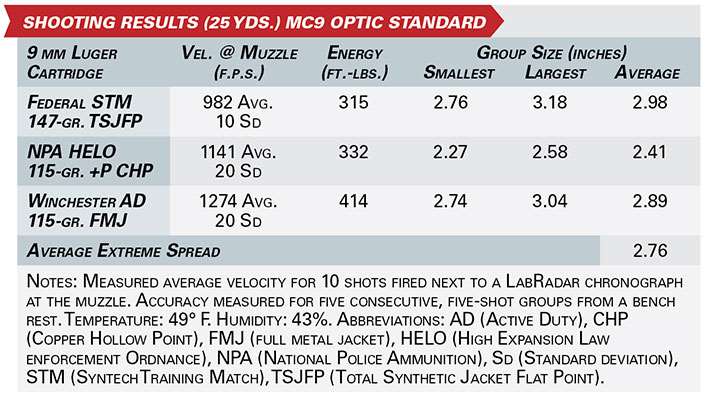
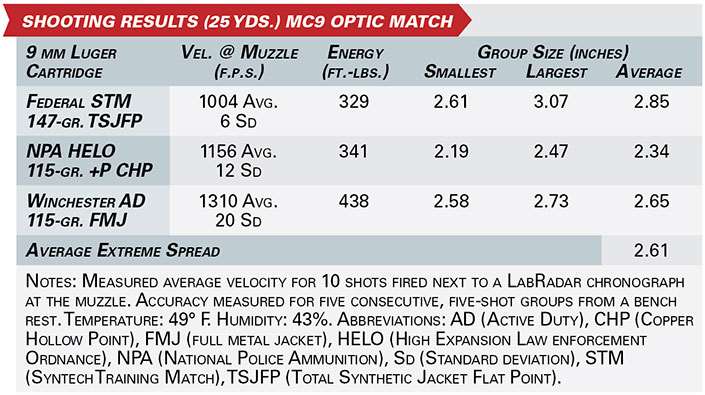
Thus, the ammunition used for the formal bench-rested accuracy testing was selected specifically to represent the range of 9 mm Luger ammunition options currently available. Loads included a relatively slow and heavy target competition load, a premium all-copper hollow point and a higher velocity full-metal-jacket round. All three loads produced group averages that hovered around the 2.75" mark with both pistols.
The accuracy results answered the second performance question I had in mind, namely the difference in performance between the Standard and Match models. In some cases, it seems customers have to pay a premium price for a souped-up model in order to get the level of accuracy they’re looking for. In this case, the accuracy for both pistols was quite similar, with the Match model taking the lead by a relatively slim margin. In other words, those who opt to buy the Standard model will not be getting a “dumbed-down” version of the platform.
The Girsan MC9 Optic Standard and Match pistols outfitted with EAA’s Far-Dot optic proved to be utterly reliable semi-automatic pistols that arrive ready to go to work. The quality of the Standard model is easily on par with similar duty pistols from other companies that often sell for around $200 more than the MC9’s suggested retail price—and do so without an optic installed.
The Match version looks sharp and has a suggested retail that is just over $90 more than the Standard model. This includes an extended, vented slide, interchangeable aluminum triggers and an aluminum magazine well, all of which are features that bump up the price a good deal more with other brands of factory-custom race guns.
